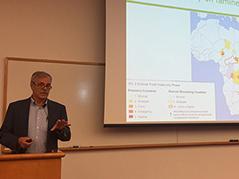 As part of the “Right to Food, Food Assistance, and the Biological Consequences of Malnutrition” Seminar Series, Dr. Dan Maxwell, the Henry J. Leir Professor in Food Security at Tufts University, presented on why famine is recurring in the 21st century, a time of declining global hunger.
As part of the “Right to Food, Food Assistance, and the Biological Consequences of Malnutrition” Seminar Series, Dr. Dan Maxwell, the Henry J. Leir Professor in Food Security at Tufts University, presented on why famine is recurring in the 21st century, a time of declining global hunger.
“Famine is a risk today; four countries are on the famine risk watch. But global food security does not drive famine. Civil conflict is the common thread for famine over multiple causes,” claimed Maxwell.
Alex Winter-Nelson, director of the ACES Office of International Programs and International Food Security at Illinois (IFSI), introduced the distinguished speaker by saying “With access to a library that houses more than 14 million volumes, I don’t buy many books, but I did buy this book,” as he held up Food Aid After 50 Years: Recasting its role (Priorities for Development Economics) that was co-authored by Maxwell.
During the well-attended seminar, Maxwell reviewed trends of famine, clarified the definition of famine, discussed recent famine events, and suggested what can be done to control famine.
He said steady if uneven progress had been made towards alleviating hunger from the 1990s through 2015.
“But last year [2016] the numbers started creeping up. Right now we have four countries on the watch list for famine, and this is a reversal in the fight against hunger,” he warned.
“Famines are logical outcomes of processes that take years to develop,” he noted.
Maxwell shared the Integrated Phase Classification Tool which determines an area is officially in famine status if:
- 20% of households have no access to food
- 30% of children under 5 are at less than the expected median for gender malnutrition
- Mortality is 2/10,000 per day
“For a famine declaration, we have to observe all three of these things at once,” he said while noting the official determination of famine is often at odds with the local perception.
He discussed in depth the Somalian famine of 2011 as well as the four areas currently on famine-risk watch (with at risk populations noted): Northeast Nigeria (5.2 million), South Sudan (6.1 million), Yemen (17.1 million), and Somalia (3.3 million).
Conflict is common factor over multiple causes
Maxwell noted that frequently mentioned causes of famine include: shortfalls in production, over population, drought, and failures of government. He said all of these are partial truths that can lead to famine, and for example, in 2011 Somalia, many factors led to the famine that killed a quarter of a million people, including drought, market shock, conflict, and constraints on major food programs.
“But famine plotted against population growth shows no relationship,” he showed.
In South Sudan the famine from 2013 to the present, is almost entirely driven by conflict, and the common factor across all of these famine situations, is civil conflict, he said.
What can we do?
If we recognize conflict as the common factor, he urged, we can do some things differently to alleviate famine:
1. Improve the way we do analysis. This would include understanding the causes, complicating factors, and timeliness of intervention, not just outcomes; and broadening the scope of analysis to recognize background factors, chronic vulnerability, and relative strength of social networks.
2. Think about how we work in conflict. We need much better conflict analysis, he said. We need to highlight the links of humanitarian protection and humanitarian provision of assistance.
3. Consider new approaches to response. We need integrated approaches (i.e. not just food), better coordination, and earlier responses, he said.
4. Build resilience and practice early intervention. We need to reduced long-term vulnerability, diversity assets and risks and strengthen livelihoods. We need to assist the chronically vulnerable in “normal” times and assist a humanitarian caseload in “bad” times.
5. Hold stakeholders accountable. We need to admit that actual famines almost always include a “man-made” element. If people can cause famines (or allow them to happen) they can also prevent them, he said.
He closed by emphasizing that food insecurity does not drive famine, conflict does.
“Humanitarian relief tires to be apolitical but people need to be more politically engaged to stop famine,” he said.
The seminar series was co-sponsored by the Division of Nutritional Sciences and International Food Security at Illinois. This series grounded a discussion of a right to food and programs to ensure that right is realized in the latest discoveries about the physical effects of food inadequacy. The series serves as a graduate seminar (DNS 500) and is also open to the campus community at large.
Article submitted by Leslie Myrick, 217-244-5373
Sources: No sources found